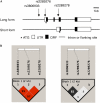Thymic stromal lymphopoietin gene promoter polymorphisms are associated with susceptibility to bronchial asthma
- PMID: 20656951
- PMCID: PMC3159073
- DOI: 10.1165/rcmb.2009-0418OC
Thymic stromal lymphopoietin gene promoter polymorphisms are associated with susceptibility to bronchial asthma
Abstract
Thymic stromal lymphopoietin (TSLP) triggers dendritic cell--mediated T helper (Th) 2 inflammatory responses. A single-nucleotide polymorphism (SNP), rs3806933, in the promoter region of the TSLP gene creates a binding site for the transcription factor activating protein (AP)-1. The variant enhances AP-1 binding to the regulatory element, and increases the promoter--reporter activity of TSLP in response to polyinosinic-polycytidylic acid (poly[I:C]) stimulation in normal human bronchial epithelium (NHBE). We investigated whether polymorphisms including the SNP rs3806933 could affect the susceptibility to and clinical phenotypes of bronchial asthma. We selected three representative (i.e., Tag) SNPs and conducted association studies of the TSLP gene, using two independent populations (639 patients with childhood atopic asthma and 838 control subjects, and 641 patients with adult asthma and 376 control subjects, respectively). We further examined the effects of corticosteroids and a long-acting β(2)-agonist (salmeterol) on the expression levels of the TSLP gene in response to poly(I:C) in NHBE. We found that the promoter polymorphisms rs3806933 and rs2289276 were significantly associated with disease susceptibility in both childhood atopic and adult asthma. The functional SNP rs3806933 was associated with asthma (meta-analysis, P = 0.000056; odds ratio, 1.29; 95% confidence interval, 1.14-1.47). A genotype of rs2289278 was correlated with pulmonary function. Moreover, the induction of TSLP mRNA and protein expression induced by poly(I:C) in NHBE was synergistically impaired by a corticosteroid and salmeterol. TSLP variants are significantly associated with bronchial asthma and pulmonary function. Thus, TSLP may serve as a therapeutic target molecule for combination therapy.
Figures





Similar articles
-
Two single nucleotide polymorphisms in TSLP gene are associated with asthma susceptibility in Chinese Han population.Exp Lung Res. 2012 Oct;38(8):375-82. doi: 10.3109/01902148.2012.714840. Epub 2012 Aug 22. Exp Lung Res. 2012. PMID: 22913730
-
Functional analysis of the thymic stromal lymphopoietin variants in human bronchial epithelial cells.Am J Respir Cell Mol Biol. 2009 Mar;40(3):368-74. doi: 10.1165/rcmb.2008-0041OC. Epub 2008 Sep 11. Am J Respir Cell Mol Biol. 2009. PMID: 18787178
-
Association between Two Single Nucleotide Polymorphisms of Thymic Stromal Lymphopoietin (TSLP) Gene and Asthma in Iranian Population.Iran J Allergy Asthma Immunol. 2020 Aug 25;19(4):362-372. doi: 10.18502/ijaai.v19i4.4111. Iran J Allergy Asthma Immunol. 2020. PMID: 33463103
-
Association between bronchial asthma and TSLP gene polymorphism: a systematic review and meta-analysis.Ann Med Surg (Lond). 2024 May 6;86(8):4684-4694. doi: 10.1097/MS9.0000000000002107. eCollection 2024 Aug. Ann Med Surg (Lond). 2024. PMID: 39118763 Free PMC article. Review.
-
Expression and Regulation of Thymic Stromal Lymphopoietin and Thymic Stromal Lymphopoietin Receptor Heterocomplex in the Innate-Adaptive Immunity of Pediatric Asthma.Int J Mol Sci. 2018 Apr 18;19(4):1231. doi: 10.3390/ijms19041231. Int J Mol Sci. 2018. PMID: 29670037 Free PMC article. Review.
Cited by
-
Potential New Inflammatory Markers in Bronchiectasis: A Literature Review.Curr Issues Mol Biol. 2024 Jun 29;46(7):6675-6689. doi: 10.3390/cimb46070398. Curr Issues Mol Biol. 2024. PMID: 39057040 Free PMC article. Review.
-
Cellular and molecular mechanisms of TSLP function in human allergic disorders--TSLP programs the "Th2 code" in dendritic cells.Allergol Int. 2012 Mar;61(1):35-43. doi: 10.2332/allergolint.11-RAI-0376. Epub 2011 Dec 25. Allergol Int. 2012. PMID: 22189594 Free PMC article. Review.
-
Genetic Mechanisms of Asthma and the Implications for Drug Repositioning.Genes (Basel). 2018 May 3;9(5):237. doi: 10.3390/genes9050237. Genes (Basel). 2018. PMID: 29751569 Free PMC article. Review.
-
Thymic stromal lymphopoietin, skin barrier dysfunction, and the atopic march.Ann Allergy Asthma Immunol. 2021 Sep;127(3):306-311. doi: 10.1016/j.anai.2021.06.004. Epub 2021 Jun 19. Ann Allergy Asthma Immunol. 2021. PMID: 34153443 Free PMC article. Review.
-
Cytokine and Lipid Mediator Regulation of Group 2 Innate Lymphoid Cells (ILC2s) in Human Allergic Airway Disease.J Cytokine Biol. 2017 Aug;2(2):116. doi: 10.4172/2576-3881.1000116. Epub 2017 Aug 4. J Cytokine Biol. 2017. PMID: 28959799 Free PMC article.
References
-
- Reche PA, Soumelis V, Gorman DM, Clifford T, Liu MR, Travis M, Zurawski SM, Johnston J, Liu YJ, et al. Human thymic stromal lymphopoietin preferentially stimulates myeloid cells. J Immunol 2001;167:336–343. - PubMed
-
- Soumelis V, Reche PA, Kanzler H, Yuan W, Edward G, Homey B, Gilliet M, Ho S, Antonenko S, Lauerma A, et al. Human epithelial cells trigger dendritic cell mediated allergic inflammation by producing TSLP. Nat Immunol 2002;3:673–680. - PubMed
-
- Ying S, O'Connor B, Ratoff J, Meng Q, Mallett K, Cousins D, Robinson D, Zhang G, Zhao J, Lee TH, et al. Thymic stromal lymphopoietin expression is increased in asthmatic airways and correlates with expression of Th2-attracting chemokines and disease severity. J Immunol 2005;174:8183–8190. - PubMed
-
- Ziegler SF, Liu YJ. Thymic stromal lymphopoietin in normal and pathogenic T cell development and function. Nat Immunol 2006;7:709–714. - PubMed
Publication types
MeSH terms
Substances
Grants and funding
LinkOut - more resources
Full Text Sources
Other Literature Sources
Medical

